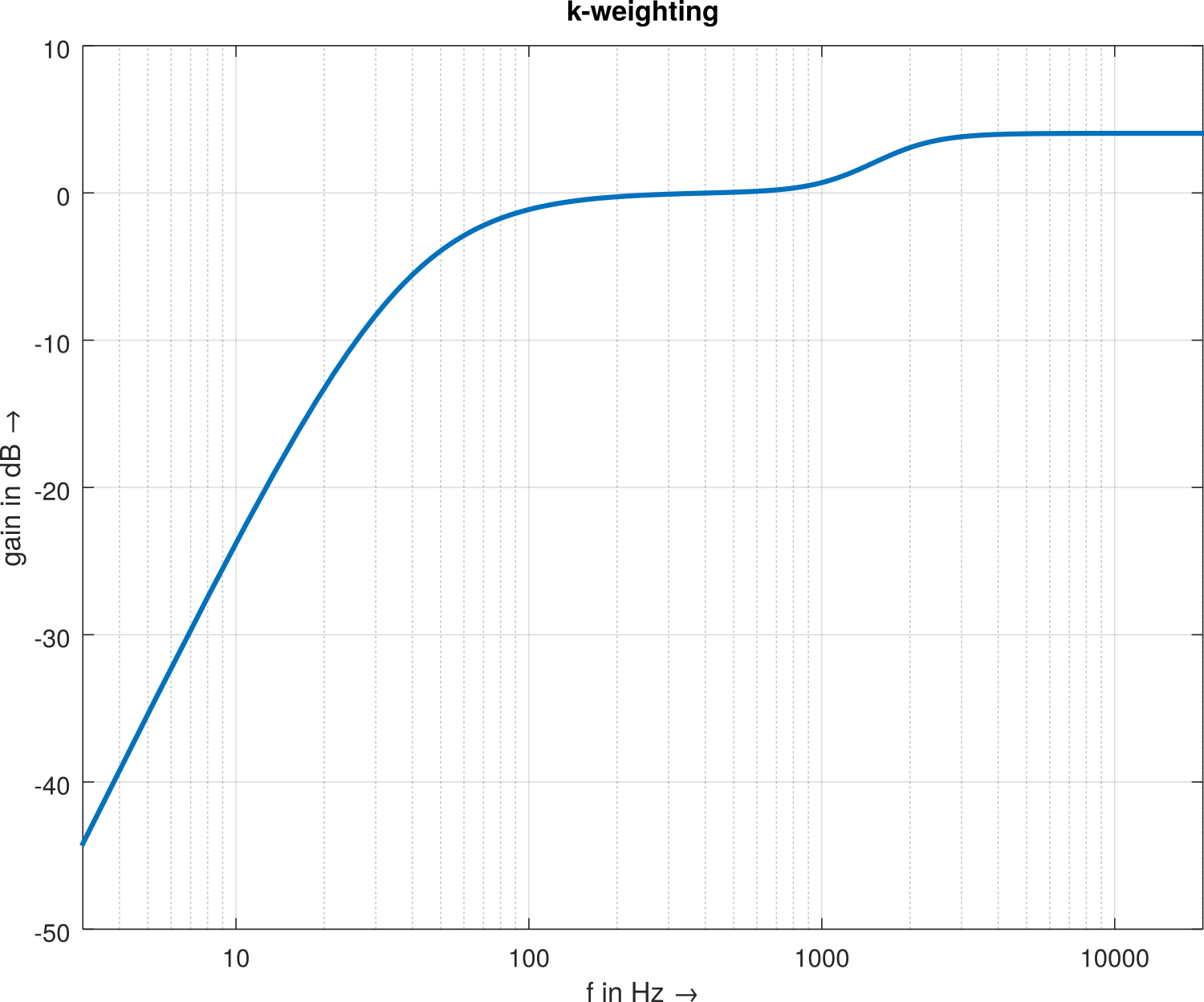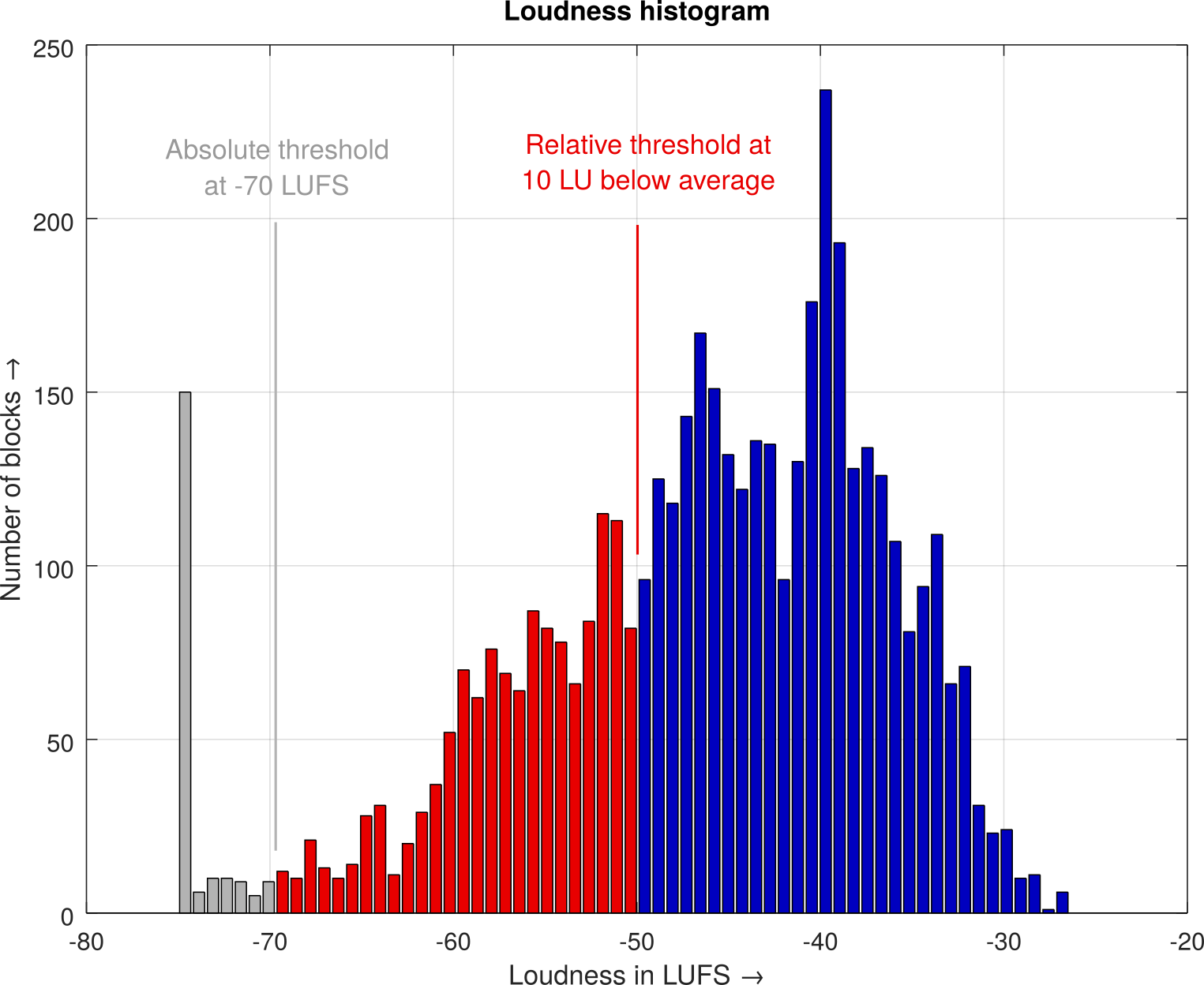SciTech-AV-Audio-DAP(Digital Audio Processing)-Perceived Loudness(感知响度)-EBU R 128 / ITU-R Bs.1770-4
Perceived Loudness (EBU R 128)
EBU: European Broadcasting Union
Example of Implementation(Source Code):
https://github.com/jiixyj/libebur128
The specification EBU R 128 / ITU-R Bs.1770-4 describes an algorithm for calculation of the perceived loudness of real world audio signals, for example no pure sine tones.
For details of the recommendations please see EBU R128 Loudness normalisation and permitted maximum level of audio signals.
LUFS

k frequency weighting function
the k-weighting approximates the characteristics of the human ear
EBU R 128 loudness is:
- measured in LUFS (Loudness Units Full Scale, or equivalently LKFS, Loudness k-weighted Full Scale) for absolute values or LU (Loudness Units) for relative values, whereat 0 LUFS are equivalent to full scale.
- The loudness is defined as the k-weighted (see Filter Curve EQ or Graphic EQ) sum of the squared values of all channels, in which the k-weighting
approximatesthe characteristics of the human ear. Thus, LU are somewhat related to the mean square without root. - Usually, the perceived loudness
is calculated inblocks of 400 milliseconds every 100 milliseconds** (so called momentary loudness). - LU's
are definedfrom a physical point of view that multiple audio sources add up within air and thus the loudnessincreases byadding another audio source. A consequence of the LU definition is that the amplitude of multi-channel audiodecreases ifanother channels is addedwhilethe loudness is kept constant.
Multi-channel audio
In multi-channel audio, the individual channels are weighted before adding them to the total loudness. In Audacity's case which supports only mono and stereo tracks at the time of writing, all channels have equal contribution.
LU's are defined from a physical point of view that multiple audio sources add up within air and thus the loudness increases by adding another audio source. A consequence of the LU definition is that the amplitude of multi-channel audio decreases if another channels is added while the loudness is kept constant. While this point of view is completely valid it causes problems together with all known PC audio drivers. Those drivers simply double mono signals that are played on stereo speakers without attenuating their value which results in the double playback loudness. To compensate this, Audacity's Loudness Normalization effect has an option to take this loudness doubling into account.
Integrative loudness and loudness gating

Loudness gating example
Since the perceived loudness is
mostly determined bythe louder parts of a track,
an accurate loudness measurementhas to ignorequier or even silent parts.
Thisis realized byloudness gating.
- Absolute Threshold: First, loudness gating as defined by EBU R 128
discardsall measurement blocks that are below an absolute threshold of -70 LUFS(grey in the examplehistogram, the large peak in the lowest bin iscaused bysilence at the start and end of the track).- Relative Threshold: In the next step, a relative threshold
is calculated10 LU below the average of the blocks above -70 LUFS(red in the examplehistogram, since the average is -40 LUFS).
All blocks below that relative thresholdare discarded as well.- the Perceived Loudness: Finally, the perceived loudness
is calculated asthe average of the remaining blocks (blue in the examplehistogram).
THE SPECIFICATION OF EBU R 128
R 128 LOUDNESS NORMALISATION AND PERMITTED MAXIMUM LEVEL OF AUDIO SIGNALS
Status: EBU Recommendation
Geneva, November 2023
EBU R 128-2023
Audio loudness normalisation & permitted maximum level
Loudness normalisation and permitted maximum level of audio signals
The EBU has studied the needs of audio signal levels in production, distribution and transmission of broadcast programmes.
- It is of the opinion that an audio-levelling paradigm based on loudness is needed.
The EBU recommendsthe measurement of the average loudness of a programme ('Programme Loudness') for the normalisation of audio signals.- The 'Maximum True Peak Level' of an audio signal
should be used to check compliance withthe upper technical limit of the signal chain. - The measures 'Loudness Range', 'Maximum Momentary Loudness' and 'Maximum Short-term Loudness'
can be used tofurther characterise an audio signal as well as to fulfil the aesthetic needs of each programme/stationdepending onthe genre(s), the target audience and the distribution platform.
The EBU, considering:
- a) that peak normalisation of audio signals has led to considerable loudness differences between programmes and between broadcast channels;
- b) that the resulting loudness inconsistencies between programmes and between channels are the cause of the most viewer/listener complaints;
- c) that, when used to read peaks in the usual way, the QPPM(Quasi-Peak Programme Meter) specified in EBU Tech 3205-E [1]
does not reflectthe loudness of an audio signal, and that the QPPMis not designed to indicatea long-term average; - d) that with the proliferation of digital
production,distributionandtransmissionsystems, the permitted maximum level of an audio signal specified in ITU-R BS.645 [2] is no longer appropriate; - e) that measuring audio programme loudness has been defined in ITU-R BS.1770 [3],
introducing the measuresLU (Loudness Unit) and LUFS (Loudness Units, referenced to Full Scale)1; - f) and that the level-gated measurement of Programme Loudness defined in ITU-R BS.1770 Eq.(7) (which hence measures foreground loudness) is advantageous to improve the loudness matching of programmes with a wide loudness range;
recommends:
7. g) that the measure Programme Loudness shall generally be used to normalise an audio signal;
8. h) that the Programme Loudness Level shall be normalised to a Target Level of −23.0 LUFS. Where attaining the Target Level is not achievable practically (for example, live programmes), a tolerance of ±1.0 LU is permitted. A broadcaster should ensure that a deviation from the Target Level towards the limits of the tolerance does not become standard practice;
9. i) that for the implementation of Loudness workflows (for example, in Quality Control environments) a tolerance of ±0.2 LU is allowed in order to take account of measurement errors;
10. j) that in special cases the Programme Loudness Level may be normalised to a Target Level lower than −23.0 LUFS on purpose. This exception shall be clearly indicated to ensure that such a lower Programme Loudness Level is not compensated;
11. k) that the measurement shall be made with a loudness meter compliant with ITU-R BS.1770 (including the level-gating method described in equation (7)) and EBU Tech 3341 [4];
12. l) that the audio signal shall generally be measured in its entirety, without emphasis on specific foreground elements such as speech, music or sound effects;
13. m)and that the True Peak Level of a programme shall not exceed −1 dBTP (dB True Peak) during production (linear audio), measured with a meter compliant with ITU-R BS.1770 and EBU Tech 3341. The measurement tolerance is ±0.3 dB (for signals with a bandwidth limited to 20 kHz). Permitted Maximum True Peak Levels may be lower for different distribution systems and data reduction rates. A broadcaster should check EBU Tech 3344 [5] for details;
The EBU further recommends:
14. n) that the measure Loudness Range (measured in compliance with EBU Tech 3342 [6]) may be used to evaluate the loudness variation of a programme2, its potential subsequent dynamic treatment and the dynamic integrity of a distribution path;
15. o) that Maximum Momentary Loudness and Maximum Short-term Loudness (measured in compliance with EBU Tech 3341) may be used to determine if a programme exceeds the upper loudness tolerance limit of the target audience;
16. p) that Loudness Metadata shall correctly indicate the actual Programme Loudness. Additional metadata may be used by the broadcaster to ensure a playback loudness level deviating from the Target Level (for example, for programmes according to item j));
17. q) that production and normalisation of short-form content (adverts; promos etc.) should be made in compliance with EBU R 128 s1 [7];
18. r) that guidance for the normalisation of content for streaming is given in EBU R 128 s2 [8];
19. s) that guidance for Loudness in Radio is given in EBU R 128 s3 [9] and EBU Tech 3401 [10];
20. t) that guidance for Loudness normalisation of Cinematic Content is given in EBU R 128 s4 [11];
21. u) that audio processes, systems and operations concerning production of programmes should be made in compliance with EBU Tech 3343 [12];
22. v) and that audio processes, systems and operations concerning distribution and reproduction of programmes should be made in compliance with EBU Tech 3344.
Notes :
- For programmes shorter than 1 minute, the use of the measure Loudness Range is not recommended due to too few data points (Loudness Range is based on the Short-term-Loudness values (3-seconds-window)).
- LUFS' is equivalent to 'LKFS' (which is used in ITU-R BS.1770).
The EBU uses 'LUFS' whichis compliant withinternational naming conventions.
Definitions
- Programme: An individual, self-contained audio-visual or audio-only item to be presented in Radio, Television or other electronic media. An advertisement (commercial), trailer, promotional item (‘promo’), interstitial or similar item (“Short-form Content”) shall also be considered to be a programme in this context.
- Programme Loudness: The integrated loudness over the duration of a programme -Programme Loudness Level is the value (in LUFS) of Programme Loudness.
- Loudness Range (LRA): The distribution of loudness within a programme
- Maximum True Peak Level: The maximum value of the audio signal waveform of a programme in the continuous time domain
References
[1] EBU Tech 3205-E 'The EBU standard peak-programme meter for the control of international transmissions'
[2] ITU-R BS.645 'Test signals and metering to be used on international sound programme connections'
[3] ITU-R BS.1770 'Algorithms to measure audio programme loudness and true-peak audio level'
[4] EBU Tech 3341 'Loudness Metering: "EBU Mode" metering to supplementloudness normalisation in accordance with EBU R 128'
[5] EBU Tech 3344 'Guidelines for Distribution and Reproduction of Programmes in accordance with EBU R 128'
[6] EBU Tech 3342 'Loudness Range: A measure to supplement loudness normalisation in accordance with EBU R 128'
[7] EBU R 128 s1 'Loudness Parameters for Short-form Content (Adverts; Promos etc.)' supplement 1 to EBU R 128
[8] EBU R 128 s2 'Loudness in Streaming'; supplement 2 to EBU R 128
[9] EBU R 128 s3 'Loudness in Radio; supplement 3 to EBU R 128
[10] EBU Tech 3401 'Guidelines for Radio production and distribution in accordance with EBU R 128'
[11] EBU R 128 s4 'Loudness normalization for Cinematic Content; supplement 4 to EBU R 128'
[12] EBU Tech 3343 'Guidelines for Production of Programmes in accordance with EBU R 128'